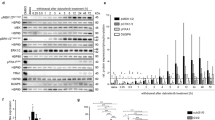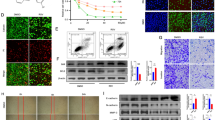Abstract
Although sEH inhibitors are well studied in inflammatory and cardiovascular diseases, their effects on gliomas are unclear. In this study, we investigated the effects of t-AUCB, a more potent and selective sEH inhibitor, on U251 and U87 human glioblastoma cell lines and the HepG2 human hepatocellular carcinoma cell line. Our results showed that t-AUCB efficiently inhibited sEH activities in all three cell lines (the inhibition rate was more than 80% in each) and suppressed U251 and U87 cell growth in a dose-dependent manner, but exhibited no cell growth inhibition on HepG2. We detected high levels of phosphorylated NF-κB-p65 (Ser536) in t-AUCB-treated U251 and U87 cells, and then found that the NF-κB inhibitor PDTC can completely abolish t-AUCB-induced growth inhibition. This indicated that t-AUCB suppresses U251 and U87 cell growth by activating NF-κB-p65. Moreover, we found that t-AUCB induces cell-cycle G0/G1 phase arrest by regulating Cyclin D1 mRNA and protein levels and CDC2 (Thr161) phosphorylation level. We propose to further test this promising reagent for its anti-glioma activity in clinical relevant orthotopic brain glioma models.




Similar content being viewed by others
References
Ranza E, Mazzini G, Facoetti A, Nano R (2010) In vitro effects of the tyrosine kinase inhibitor imatinib on glioblastoma cell proliferation. J Neurooncol 96:349–357. doi:10.1007/s11060-009-9975-4
Abacioglu U, Caglar HB, Yumuk PF, Akgun Z, Atasoy BM, Sengoz M (2011) Efficacy of protracted dose-dense temozolomide in patients with recurrent high-grade glioma. J Neurooncol 103:585–593. doi:10.1007/s11060-010-0423-2
Reardon DA, Desjardins A, Peters KB, Gururangan S, Sampson JH, McLendon RE, Herndon JE 2nd, Bulusu A, Threatt S, Friedman AH, Vredenburgh JJ, Friedman HS (2011) Phase II study of carboplatin, irinotecan, and bevacizumab for bevacizumab naive, recurrent glioblastoma. J Neurooncol. doi:10.1007/s11060-011-0722-2
Reardon DA, Vredenburgh JJ, Coan A, Desjardins A, Peters KB, Gururangan S, Sathornsumetee S, Rich JN, Herndon JE, Friedman HS (2011) Phase I study of sunitinib and irinotecan for patients with recurrent malignant glioma. J Neurooncol. doi:10.1007/s11060-011-0631-4
Davis BB, Liu JY, Tancredi DJ, Wang L, Simon SI, Hammock BD, Pinkerton KE (2011) The anti-inflammatory effects of soluble epoxide hydrolase inhibitors are independent of leukocyte recruitment. Biochem Biophys Res Commun 410:494–500. doi:10.1016/j.bbrc.2011.06.008
Luria A, Bettaieb A, Xi Y, Shieh GJ, Liu HC, Inoue H, Tsai HJ, Imig JD, Haj FG, Hammock BD (2011) Soluble epoxide hydrolase deficiency alters pancreatic islet size and improves glucose homeostasis in a model of insulin resistance. Proc Natl Acad Sci USA 108:9038–9043. doi:10.1073/pnas.1103482108
Ni GH, Chen JF, Chen XP, Yang TL (2011) Soluble epoxide hydrolase: a promising therapeutic target for cardiovascular diseases. Pharmazie 66:153–157
Schebb NH, Huby M, Morisseau C, Hwang SH, Hammock BD (2011) Development of an online SPE-LC-MS-based assay using endogenous substrate for investigation of soluble epoxide hydrolase (sEH) inhibitors. Anal Bioanal Chem 400:1359–1366. doi:10.1007/s00216-011-4861-2
Koeners MP, Wesseling S, Ulu A, Sepulveda RL, Morisseau C, Braam B, Hammock BD, Joles JA (2011) Soluble epoxide hydrolase in the generation and maintenance of high blood pressure in spontaneously hypertensive rats. Am J Physiol Endocrinol Metab 300:E691–E698. doi:10.1152/ajpendo.00710.2010
Panigrahy D, Kaipainen A, Greene ER, Huang S (2010) Cytochrome P450-derived eicosanoids: the neglected pathway in cancer. Cancer Metastasis Rev 29:723–735. doi:10.1007/s10555-010-9264-x
Liu JY, Tsai HJ, Hwang SH, Jones PD, Morisseau C, Hammock BD (2009) Pharmacokinetic optimization of four soluble epoxide hydrolase inhibitors for use in a murine model of inflammation. Br J Pharmacol 156:284–296. doi:10.1111/j.1476-5381.2008.00009.x
Liu JY, Yang J, Inceoglu B, Qiu H, Ulu A, Hwang SH, Chiamvimonvat N, Hammock BD (2010) Inhibition of soluble epoxide hydrolase enhances the anti-inflammatory effects of aspirin and 5-lipoxygenase activation protein inhibitor in a murine model. Biochem Pharmacol 79:880–887. doi:10.1016/j.bcp.2009.10.025
Edin ML, Wang Z, Bradbury JA, Graves JP, Lih FB, Degraff LM, Foley JF, Torphy R, Ronnekleiv OK, Tomer KB, Lee CR, Zeldin DC (2011) Endothelial expression of human cytochrome P450 epoxygenase CYP2C8 increases susceptibility to ischemia-reperfusion injury in isolated mouse heart. FASEB J. doi:10.1096/fj.11-188300
Spector AA, Fang X, Snyder GD, Weintraub NL (2004) Epoxyeicosatrienoic acids (EETs): metabolism and biochemical function. Prog Lipid Res 43:55–90. doi:S0163782703000493
Deng Y, Theken KN, Lee CR (2010) Cytochrome P450 epoxygenases, soluble epoxide hydrolase, and the regulation of cardiovascular inflammation. J Mol Cell Cardiol 48:331–341. doi:10.1016/j.yjmcc.2009.10.022
Tran L, Kompa AR, Wang BH, Krum H (2011) Evaluation of the effects of urotensin II and soluble epoxide hydrolase inhibitor on skin microvessel tone in healthy controls and heart failure patients. Cardiovasc Ther. doi:10.1111/j.1755-5922.2011.00282.x
Liu JY, Qiu H, Morisseau C, Hwang SH, Tsai HJ, Ulu A, Chiamvimonvat N, Hammock BD (2011) Inhibition of soluble epoxide hydrolase contributes to the anti-inflammatory effect of antimicrobial triclocarban in a murine model. Toxicol Appl Pharmacol 255:200–206. doi:10.1016/j.taap.2011.06.017
de Visser KE, Eichten A, Coussens LM (2006) Paradoxical roles of the immune system during cancer development. Nat Rev Cancer 6:24–37. doi:10.1038/nrc1782
Enayetallah AE, French RA, Grant DF (2006) Distribution of soluble epoxide hydrolase, cytochrome P450 2C8, 2C9 and 2J2 in human malignant neoplasms. J Mol Histol 37:133–141. doi:10.1007/s10735-006-9050-9
Yang MD, Wu CC, Chiou SH, Chiu CF, Lin TY, Chiang IP, Chow KC (2003) Reduction of dihydrodiol dehydrogenase expression in resected hepatocellular carcinoma. Oncol Rep 10:271–276
Roques M, Bagrel D, Magdalou J, Siest G (1991) Expression of arylhydrocarbon hydroxylase, epoxide hydrolases, glutathione S-transferase and UDP-glucuronosyltransferases in H5–6 hepatoma cells. Gen Pharmacol 22:677–684
Chaudhary KR, Abukhashim M, Hwang SH, Hammock BD, Seubert JM (2010) Inhibition of soluble epoxide hydrolase by trans-4- [4-(3-adamantan-1-yl-ureido)-cyclohexyloxy]-benzoic acid is protective against ischemia-reperfusion injury. J Cardiovasc Pharmacol 55:67–73. doi:10.1097/FJC.0b013e3181c37d69
Zhao Y, Banerjee S, Lejeune WS, Choudhary S, Tilton RG (2011) NF-kappaB-inducing kinase increases renal tubule epithelial inflammation associated with diabetes. Exp Diabetes Res 2011:192564. doi:10.1155/2011/192564
Li Y, Reddy MA, Miao F, Shanmugam N, Yee JK, Hawkins D, Ren B, Natarajan R (2008) Role of the histone H3 lysine 4 methyltransferase, SET7/9, in the regulation of NF-kappaB-dependent inflammatory genes. Relevance to diabetes and inflammation. J Biol Chem 283:26771–26781. doi:10.1074/jbc.M802800200
Deng Y, Edin ML, Theken KN, Schuck RN, Flake GP, Kannon MA, DeGraff LM, Lih FB, Foley J, Bradbury JA, Graves JP, Tomer KB, Falck JR, Zeldin DC, Lee CR (2011) Endothelial CYP epoxygenase overexpression and soluble epoxide hydrolase disruption attenuate acute vascular inflammatory responses in mice. FASEB J 25:703–713. doi:10.1096/fj.10-171488
Moshal KS, Zeldin DC, Sithu SD, Sen U, Tyagi N, Kumar M, Hughes WM Jr, Metreveli N, Rosenberger DS, Singh M, Vacek TP, Rodriguez WE, Ayotunde A, Tyagi SC (2008) Cytochrome P450 (CYP) 2J2 gene transfection attenuates MMP-9 via inhibition of NF-kappabeta in hyperhomocysteinemia. J Cell Physiol 215:771–781. doi:10.1002/jcp.21356
Seitz CS, Lin Q, Deng H, Khavari PA (1998) Alterations in NF-kappaB function in transgenic epithelial tissue demonstrate a growth inhibitory role for NF-kappaB. Proc Natl Acad Sci USA 95:2307–2312
Dajee M, Lazarov M, Zhang JY, Cai T, Green CL, Russell AJ, Marinkovich MP, Tao S, Lin Q, Kubo Y, Khavari PA (2003) NF-kappaB blockade and oncogenic Ras trigger invasive human epidermal neoplasia. Nature 421:639–643. doi:10.1038/nature01283
Karin M (2009) NF-kappaB as a critical link between inflammation and cancer. Cold Spring Harb Perspect Biol 1:a000141. doi:10.1101/cshperspect.a000141
Musgrove EA, Caldon CE, Barraclough J, Stone A, Sutherland RL (2011) Cyclin D as a therapeutic target in cancer. Nat Rev Cancer 11:558–572. doi:10.1038/nrc3090
Witzel II, Koh LF, Perkins ND (2010) Regulation of cyclin D1 gene expression. Biochem Soc Trans 38:217–222. doi:10.1042/BST0380217
Fox KE, Colton LA, Erickson PF, Friedman JE, Cha HC, Keller P, MacDougald OA, Klemm DJ (2008) Regulation of cyclin D1 and Wnt10b gene expression by cAMP-responsive element-binding protein during early adipogenesis involves differential promoter methylation. J Biol Chem 283:35096–35105. doi:10.1074/jbc.M806423200
Wang J, Wang Q, Cui Y, Liu ZY, Zhao W, Wang CL, Dong Y, Hou L, Hu G, Luo C, Chen J, Lu Y (2011) Knockdown of cyclin D1 inhibits proliferation, induces apoptosis, and attenuates the invasive capacity of human glioblastoma cells. J Neurooncol. doi:10.1007/s11060-011-0692-4
Atherton-Fessler S, Liu F, Gabrielli B, Lee MS, Peng CY, Piwnica-Worms H (1994) Cell cycle regulation of the p34cdc2 inhibitory kinases. Mol Biol Cell 5:989–1001
Acknowledgements
We thank Professor Bruce D. Hammock for providing the sEH inhibitor t-AUCB, Professor Kun Yao for providing U251 and U87 human glioblastoma cell lines and Doctor Wenjie Zhang for providing HepG2 human hepatocellular carcinoma cell line for these experiments. This study was supported by Jiangsu Province Science Fund (Number BK2007257).
Author information
Authors and Affiliations
Corresponding author
Rights and permissions
About this article
Cite this article
Li, J., Liu, H., Xing, B. et al. t-AUCB, an improved sEH inhibitor, suppresses human glioblastoma cell growth by activating NF-κB-p65. J Neurooncol 108, 385–393 (2012). https://doi.org/10.1007/s11060-012-0841-4
Received:
Accepted:
Published:
Issue Date:
DOI: https://doi.org/10.1007/s11060-012-0841-4




